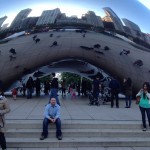“conjoined / by merest bolts of what / it doesn’t understand”:
A review of Bastard Heart
by Dale Enggass
Raphael Dagold
Silverfish Review Press 2014
72 pages
$16
Sometimes there is a shape to them, / the blackbirds—an arc or swirl, a wave, / the air like water following / itself around a rock. So begins “Dirt Heart,” the final poem in Raphael Dagold’s new collection Bastard Heart, winner of the 2012 Gerald Cable book award. The shapeless yet shaping, ephemeral yet fixed image of a flock of blackbirds moving across the sky is a kind of structuring motif of the book, a refrain that encapsulates these poems’ fascination with frames and the act of framing—with invisible processes and their material effects. The blackbirds (always plural) make visible, again and again, a collapse of perspective: the birds form
…a startle
low across the dirt, the air full with it,
almost swollen, so large, right there,
as if the sky were in front of your face,
something to rush towards and be in it
like a building half demolished
The ability to see is both facilitated and compromised by such half-structures, frames slowly mutating through the machinations of entropy. The “building half-demolished,” blurring inside and outside, allowing the background of sky to spill into the foreground, is “more present, these fleshy cavities, / than in its life of still composure” and allows one “to be in it, eye mesmerized, / no scale anymore, to rush in / and through it.” This immersive, perspectiveless experience of space, “Where the blackbirds have / broken and made their shape,” is reflected in Dagold’s syntax, spare and fragmented, which rejects the lyric’s over-fondness for a kind of “still life” mode, as hinted at in the undamaged building’s “life of still composure.”
Dagold’s poems are expressly uninterested in “still composure,” which isn’t to say they are not meticulously, and often dazzlingly, composed. Yet one of Bastard Heart’s more striking characteristics is its diversity: the poems range from a kind of lyric of close attention (as in “Dirt Heart,” above), to narrative poems often concerning childhood memories and domestic upheaval (“Learning to Eat Apples,” “For Whom,” “In the Field”), to surrealist-inflected list-poems (“Catalogue: Butcher’s Hill, Baltimore, Summer 1988” in which appears “a motorcycle burning ten feet from a stop sign”), to almost essayistic poems intertwining Jewish history, contemporary events, and personal identity (“Parts Unknown,” “Spinoza,” “January 1995”).
Dagold, who is also an excellent writer of surreal, darkly comic fables, is at his strongest when his verse bends toward the strange and incongruous. In “Seeing My Wife at the Whitney,” for instance, the speaker, hypnotized by “Steichen’s early landscapes” and gazing “into plantinum, silver, / into gum bichromate, direct carbon / prints,” seemingly out of the blue (or black) asserts, “My wife vibrates on the floor of my brain.” It is not clear if the speaker’s “wife” is recalled in one of Steichen’s photographs (possibly one of his many eerie portraits), but such an abstract (yet still strangely sensuous) intrusion into a meditation on the material process of making (in this case a photographic print) serves to dislocate the gaze in order to see anew. As the speaker says at the beginning of the poem, “Again I’m loving what I can not see, beating / my heart against it, the black thirds / of Steichen’s early landscapes” The division of the expected “cannot” into “can not” emphasizes the positive value of the invisible, or out-of-view—that which can not be seen.
The murky “black thirds” of the photo rhyme with the “blackbirds” that make their first appearance in the following, title poem: “The blackbirds are ripping a hole / in the sky.” The protean flock is “a wave swallowing / itself. And a heart. They are a heart, / a hole, a house.” The poem enacts the flux of this flock through an abrupt mutation of syntax:
…Why they are collecting
so many black and glistening mouthfuls,
why they place themselves veiled
before fluttering up in another wave,
is anybody’s bastard heart to fill a mouth:
they are.
Rather than providing the expected cliché (“is anybody’s guess”), Dagold turns the poem’s language back in on itself, just as a flock of birds in flight will seem to twist and warp in collective rearrangement. This “bastard” syntax, impure and irresolvable, creates a poem “conjoined / by merest bolts of what / it doesn’t understand,” in which “bolts” signifies both the devices that hold a structure together and in place, and the sudden jaggedness of a flash of lightning, a momentary rift in the nature of things (“the blackbirds are ripping a hole / in the sky”), the spark of synapses firing.
Despite this gesture towards the generative potential of incomprehension, the poems in Bastard Heart more often lean towards recuperation. In “Tree Heart,” for instance, the blackbirds that begin the poem as an unruly “swarm” end the poem on a note of inclusion and even hospitality: “And they are eating. And they are making room.” And even if this particular reader wanted these poems to resist a little bit more the urge for closure—the summation-like statement that wiggles its way into the poem as a kind of aid to interpretation—it is also the case that the act of “making room” (of clearing space and of framing) is never a completed process. “An open house the heart is,” Dagold writes in the title poem, and I think not of a sentimental generosity or a confessional laying-bare, but of the “building half demolished” in “Dirt Heart,” involved in a continual process of decay, taking ever-new shapes through its own collapse.
